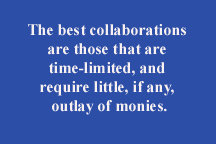|
Teaching foundation/introductory courses can be overwhelming due to the daunting task of presenting beginning values, theory,
history, and areas of practice content. The pressure to deliver on content can mask a potential resource, literally staring
you in the face, which can enrich and expand classroom learning opportunities--namely, your students.

Dust off your mentor role and look no further than to the potential of your students if you desire to add a dimension of experiential
learning and self-discovery in your foundation course.
Foundation courses serve a couple of purposes: one, they begin to inform students of the values, knowledge, and skills
of the social work profession; two, they encourage students to reflect on the 'fit' of social work as a possible major and
ultimately as a career track. What better way to address the outcome of knowledge integration and the enhancement of reflection
opportunities, than to bring life to concepts that, up to this point, were simply academic?
Participation in NASW Lobby Day activities is a great example of successful student-faculty collaboration. Lobby Day efforts
are seen by students as being beneficial because, besides providing for a much-welcomed road trip, participants are putting
into practice concepts they have been reading and discussing in class. Additionally, a Lobby Day entails students working
with faculty in preparation, organization, and execution of the planned-for activities; in other words, a collaboration. Why
not provide opportunities for faculty-student collaborations throughout the BSW curriculum, and in particular, early on in
students' academic life when they are attempting to come to grips with major academic and career decisions?
Keys to Successful Collaboration
Seize The Learning Opportunity
Keep in mind that you are a role model for your students and that often you will be their first impression of social work.
There is no better time than during your foundation course to begin their acculturation to the profession.
Admit It, You've Become A Mentor (and you like it!)
Your expertise, your experiences, your views on social work and how the world works, are especially important to beginning
students as they try to make sense of this thing called social work. Give yourself some credit-- you have much to offer to
your students.
Start Where The Student Is
Look no further than the life-space of the students to find opportunities rich for small-scale mentoring. Students come pre-packaged
with values, interests, and access to family, friendship, and a myriad of other, systems-- in other words, they have a life.
Modeling a strengths-based approach, why not ask your students what they feel passionately about? Chances are good that a
collaboration can be created around something that will hold their interest. Developing a collaboration within the students'
sphere of interest brings concepts to life at a point where the student can see real connections with concerns they value.
It also demonstrates that there is no shortage of systems where the knowledge and values of the profession can be applied.
Short-Term And Low/No Cost
Both time and funding, for the student and for the faculty person, are in short supply. The best collaborations are those
that are time-limited and require little, if any, outlay of actual monies. Any potential collaboration that necessitates that
a budget be developed and/or presents a major disruption in the schedule of either the student or faculty member, should be
discouraged and saved for another time and place. A hint: keep it simple.
Keep The Learning In Front Of You
Throughout the span of the collaboration, from beginning ideas to ending reflections and thoughts, be very clear with the
students as to how their collaboration experience is tied to social work concepts/knowledge. Be direct in making these connections.
There Is No Such Thing As A Collaboration That Is Too Small!
I view potential collaborations through the following themes:
-social action/community awareness
-issue investigation
-values testing
Fully realizing that the above themes are neither mutually exclusive nor all-encompassing, I've found that their real
value is that they serve as starting points from which I can view student interests/experiences.
|
